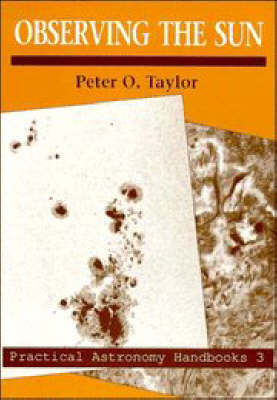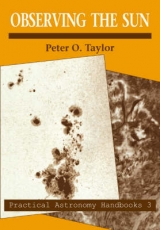
Observing the Sun
Seiten
1991
Cambridge University Press (Verlag)
978-0-521-40110-4 (ISBN)
Cambridge University Press (Verlag)
978-0-521-40110-4 (ISBN)
- Titel erscheint in neuer Auflage
- Artikel merken
Zu diesem Artikel existiert eine Nachauflage
A clear and practical account of everything that a telescope user needs to know in order to make solar observations.
Observing the Sun is one of the most interesting and rewarding facets of astronomy to which amateurs can contribute. Few areas of science offer as many opportunities to contribute meaningful data. It is the one branch of astronomy that requires only modest equipment and can be pursued during the day. Peter Taylor is a keen and highly experienced observer of the Sun. In this book he explains in a clear and practical way everything that a telescope user needs to know in order to make solar observations. The author draws on his many years of personal experience as a contributor to the Solar Division of the American Association of Variable Star Observers and to the American Sunspot Program. The book deals with the following topics: historical background, choice of equipment for the safe conduct of solar observations, observations of sunspots, and reporting observations. New techniques, such as electronic recording and the operations of radio telescopes, are included. The level of presentation is understandable to anyone with basic astronomical knowledge and some experience in handling a small telescope.
Observing the Sun is one of the most interesting and rewarding facets of astronomy to which amateurs can contribute. Few areas of science offer as many opportunities to contribute meaningful data. It is the one branch of astronomy that requires only modest equipment and can be pursued during the day. Peter Taylor is a keen and highly experienced observer of the Sun. In this book he explains in a clear and practical way everything that a telescope user needs to know in order to make solar observations. The author draws on his many years of personal experience as a contributor to the Solar Division of the American Association of Variable Star Observers and to the American Sunspot Program. The book deals with the following topics: historical background, choice of equipment for the safe conduct of solar observations, observations of sunspots, and reporting observations. New techniques, such as electronic recording and the operations of radio telescopes, are included. The level of presentation is understandable to anyone with basic astronomical knowledge and some experience in handling a small telescope.
Preface; Introduction; Historical perspective; 1. The relative sunspot number; 2. Characteristics of the sunspot-cycle; 3. The Zurich and Mount Wilson sunspot group classifications; 4. Common terrestrial effects; 5. Equipment: the telescope, aperture filters and image projection; 6. Image orientation; 7. Observing the Sun's spots and other solar phenomena; 8. Using a Porter disk to determine heliographic positions; 9. Observing solar white-light flares; 10. Detecting solar flares electronically; 11. Constructing a solar flare monitoring station; 12. Computation of observer statistical factors and other equations; 13. Solar eclipses and the amateur astronomer; References; Index.
| Erscheint lt. Verlag | 21.11.1991 |
|---|---|
| Reihe/Serie | Practical Astronomy Handbooks |
| Zusatzinfo | 22 Halftones, unspecified; 31 Line drawings, unspecified |
| Verlagsort | Cambridge |
| Sprache | englisch |
| Maße | 180 x 256 mm |
| Gewicht | 576 g |
| Themenwelt | Sachbuch/Ratgeber ► Natur / Technik ► Weltraum / Astronomie |
| ISBN-10 | 0-521-40110-0 / 0521401100 |
| ISBN-13 | 978-0-521-40110-4 / 9780521401104 |
| Zustand | Neuware |
| Haben Sie eine Frage zum Produkt? |
Mehr entdecken
aus dem Bereich
aus dem Bereich
die Suche nach der Urkraft des Universums
Buch | Hardcover (2023)
Klett-Cotta (Verlag)
25,00 €
Perspektiven auf die Menschheit
Buch | Hardcover (2024)
Klett-Cotta (Verlag)
25,00 €



